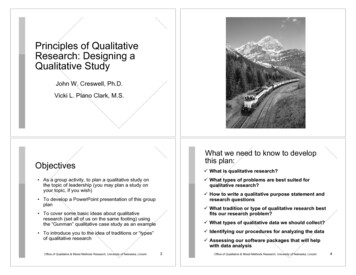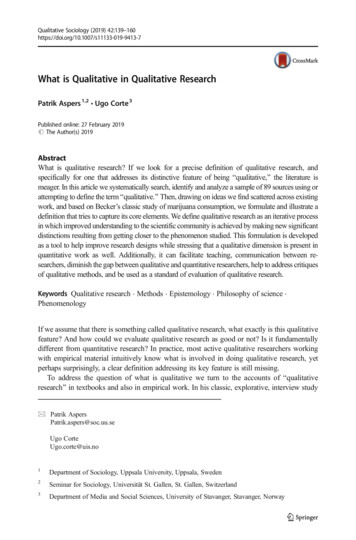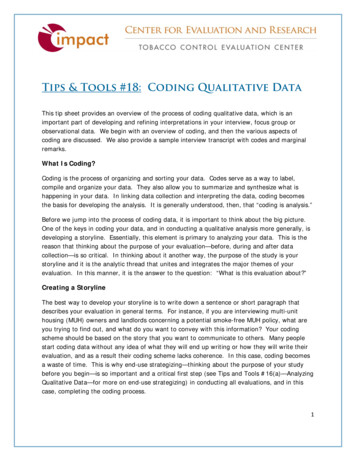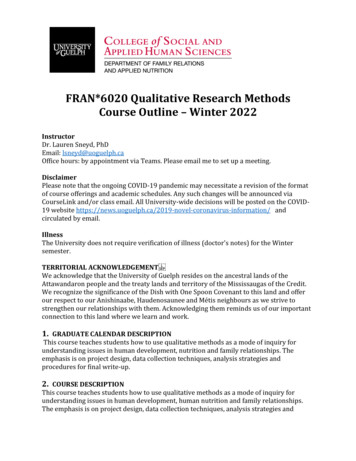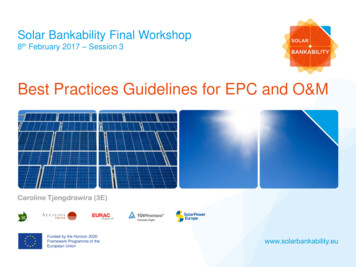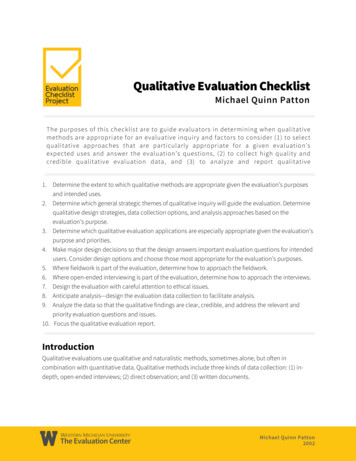
Transcription
Qualitative Evaluation ChecklistMichael Quinn PattonThe purposes of this checklist are to guide evaluators in determining when qualitativemethods are appropriate for an evaluative inquiry and factors to consider (1) to selectqualitative approaches that are particularly appropriate for a given evaluation’sexpected uses and answer the evaluation’s questions, (2) to collect high quality andcredible qualitative evaluation data, and (3) to analyze and report qualitativeevaluation findings.1. Determine the extent to which qualitative methods are appropriate given the evaluation’s purposesand intended uses.2. Determine which general strategic themes of qualitative inquiry will guide the evaluation. Determinequalitative design strategies, data collection options, and analysis approaches based on theevaluation’s purpose.3. Determine which qualitative evaluation applications are especially appropriate given the evaluation’spurpose and priorities.4. Make major design decisions so that the design answers important evaluation questions for intendedusers. Consider design options and choose those most appropriate for the evaluation’s purposes.5. Where fieldwork is part of the evaluation, determine how to approach the fieldwork.6. Where open-ended interviewing is part of the evaluation, determine how to approach the interviews.7. Design the evaluation with careful attention to ethical issues.8. Anticipate analysis—design the evaluation data collection to facilitate analysis.9. Analyze the data so that the qualitative findings are clear, credible, and address the relevant andpriority evaluation questions and issues.10. Focus the qualitative evaluation report.IntroductionQualitative evaluations use qualitative and naturalistic methods, sometimes alone, but often incombination with quantitative data. Qualitative methods include three kinds of data collection: (1) indepth, open-ended interviews; (2) direct observation; and (3) written documents.Michael Quinn Patton2002
Interviews: Open-ended questions and probes yield in-depth responses about people's experiences,perceptions, opinions, feelings, and knowledge. Data consist of verbatim quotations with sufficientcontext to be interpretable.Observations: Fieldwork descriptions of activities, behaviors, actions, conversations, interpersonalinteractions, organizational or community processes, or any other aspect of observable humanexperience. Data consist of field notes: rich, detailed descriptions, including the context within which theobservations were made.Documents: Written materials and other documents from organizational, clinical, or program records;memoranda and correspondence; official publications and reports; personal diaries, letters, artisticworks, photographs, and memorabilia; and written responses to open-ended surveys. Data consist ofexcerpts from documents captured in a way that records and preserves context.The data for qualitative evaluation typically come from fieldwork. The evaluator spends time in thesetting under study—a program, organization, or community where change efforts can be observed,people interviewed, and documents analyzed. The evaluator makes firsthand observations of activitiesand interactions, sometimes engaging personally in those activities as a "participant observer." Forexample, an evaluator might participate in all or part of the program under study, participating as aregular program member, client, or student. The qualitative evaluator talks with people about theirexperiences and perceptions. More formal individual or group interviews may be conducted. Relevantrecords and documents are examined. Extensive field notes are collected through these observations,interviews, and document reviews. The voluminous raw data in these field notes are organized intoreadable narrative descriptions with major themes, categories, and illustrative case examples extractedthrough content analysis. The themes, patterns, understandings, and insights that emerge fromevaluation fieldwork and subsequent analysis are the fruit of qualitative inquiry.Qualitative findings may be presented alone or in combination with quantitative data. At the simplestlevel, a questionnaire or interview that asks both fixed-choice (closed) questions and open-endedquestions is an example of how quantitative measurement and qualitative inquiry are often combined.The quality of qualitative data depends to a great extent on the methodological skill, sensitivity, andintegrity of the evaluator. Systematic and rigorous observation involves far more than just being presentand looking around. Skillful interviewing involves much more than just asking questions. Content analysisrequires considerably more than just reading to see what's there. Generating useful and crediblequalitative findings through observation, interviewing, and content analysis requires discipline,knowledge, training, practice, creativity, and hard work.Qualitative methods are often used in evaluations because they tell the program's story by capturing andcommunicating the participants' stories. Evaluation case studies have all the elements of a good story.They tell what happened when, to whom, and with what consequences. The purpose of such studies is togather information and generate findings that are useful. Understanding the program's and participant'sstories is useful to the extent that those stories illuminate the processes and outcomes of the program forthose who must make decisions about the program. The methodological implication of this criterion isPATTONWMICH.EDU/EVALUATION/CHECKLISTS 2
that the intended users must value the findings and find them credible. They must be interested in thestories, experiences, and perceptions of program participants beyond simply knowing how many cameinto the program, how many completed it, and how many did what afterwards. Qualitative findings inevaluation can illuminate the people behind the numbers and put faces on the statistics to deepenunderstanding.1. Determine the extent to which qualitative methods are appropriate given the evaluation’spurposes and intended uses.Be prepared to explain the variations, strengths, and weaknesses of qualitative evaluations.Determine the criteria by which the quality of the evaluation will be judged.Determine the extent to which qualitative evaluation will be accepted or controversial given theevaluation’s purpose, users, and audiences.Determine what foundation should be laid to assure that the findings of a qualitative evaluation willbe credible.2. Determine which general strategic themes of qualitative inquiry will guide the evaluation.Determine qualitative design strategies, data collection options, and analysis approaches basedon the evaluation’s purpose.Naturalistic inquiry: Determine the degree to which it is possible and desirable to study the programas it unfolds naturally and openly, that is, without a predetermined focus or preordinate categoriesof analysis.Emergent design flexibility: Determine the extent to which it will be possible to adapt the evaluationdesign and add additional elements of data collection as understanding deepens and as theevaluation unfolds. (Some evaluators and/or evaluation funders want to know in advance exactlywhat data will be collected from whom in what time frame; other designs are more open andemergent.)Purposeful sampling: Determine what purposeful sampling strategy (or strategies) will be used forthe evaluation. Pick cases for study (e.g., program participants, staff, organizations, communities,cultures, events, critical incidences) that are "information rich" and illuminative, that is, that willprovide appropriate data given the evaluation’s purpose. (Sampling is aimed at generating insightsinto key evaluation issues and program effectiveness, not empirical generalization from a sample toa population. Specific purposeful sampling options are listed later in this checklist.)Focus on priorities: Determine what elements or aspects of program processes and outcomes willbe studied qualitatively in the evaluation. PATTONDecide what evaluation questions lend themselves to qualitative inquiry, for example,questions concerning what outcomes mean to participants rather than how much of anoutcome was attained.WMICH.EDU/EVALUATION/CHECKLISTS 3
Determine what program observations will yield detailed, thick descriptions that illuminateevaluation questions. Determine what interviews will be needed to capture participants’ perspectives andexperiences. Identify documents that will be reviewed and analyzed.Holistic perspective: Determine the extent to which the final evaluation report will describe andexamine the whole program being evaluated. Decide if the purpose is to understand the program as a complex system that is more than thesum of its parts. Decide how important it will be to capture and examine complex interdependencies andsystem dynamics that cannot meaningfully be portrayed through a few discrete variables andlinear, cause-effect relationships. Determine how important it will be to place findings in a social, historical, and temporalcontext. Determine what comparisons will be made or if the program will be evaluated as a case untoitself.Voice and perspective: Determine what perspective the qualitative evaluator will bring to theevaluation. Determine what evaluator stance will be credible. How will the evaluator conduct fieldwork andinterviews and analyze data in a way that conveys authenticity and trustworthiness? Determine how balance will be achieved and communicated given the qualitative nature of theevaluation and concerns about perspective that often accompany qualitative inquiry.3. Determine which qualitative evaluation applications are especially appropriate given theevaluation’s purpose and priorities.Below are evaluation issues for which qualitative methods can be especially appropriate. This is not anexhaustive list, but is meant to suggest possibilities. The point is to assure the appropriateness ofqualitative methods for an evaluation.Checklist of standard qualitative evaluation applications—determine how important it is to: Evaluate individualized outcomes—qualitative data are especially useful where differentparticipants are expected to manifest varying outcomes based on their own individual needsand circumstances. Document the program’s processes—process evaluations examine how the program unfoldsand how participants move through the program. Conduct an implementation evaluation, that is, look at the extent to which actualimplementation matches the original program design and capture implementation variations.PATTONWMICH.EDU/EVALUATION/CHECKLISTS 4
Evaluate program quality, for example, quality assurance based on case studies. Document development over time. Investigate system and context changes. Look for unanticipated outcomes, side effects, and unexpected consequences in relation toprimary program processes, outcomes, and impacts.Checklist of qualitative applications that serve special evaluation purposes—determine howimportant it is to: Personalize and humanize evaluation—to put faces on numbers or make findings easier torelate to for certain audiences. Harmonize program and evaluation values; for example, programs that emphasizeindividualization lend themselves to case studies. Capture and communicate stories—in certain program settings a focus on “stories” is lessthreatening and more friendly than conducting case studies.Evaluation models: The following evaluation models are especially amenable to qualitativemethods—determine which you will use. Participatory and collaborative evaluations—actively involving program participants and/orstaff in the evaluation; qualitative methods are accessible and understandable tononresearchers. Goal-free evaluation—finding out the extent to which program participants’ real needs arebeing met instead of focusing on whether the official stated program goals are being attained. Responsive evaluation, constructivist evaluation, and “Fourth Generation Evaluation” (seechecklist on constructivist evaluation, a.k.a. Fourth Generation Evaluation). Developmental applications: Action research, action learning, reflective practice, and buildinglearning organizations—these are organizational and program development approaches thatare especially amenable to qualitative methods.Utilization-focused evaluation—qualitative evaluations are one option among many (see checkliston utilization-focused evaluation).4. Make major design decisions so that the design answers important evaluation questions forintended users. Consider design options and choose those most appropriate for theevaluation’s purposes.Pure or mixed methods design: Determine whether the evaluation will be purely qualitative or amixed method design with both qualitative and quantitative data.Units of analysis: No matter what you are studying, always collect data on the lowest level unit ofanalysis possible; you can aggregate cases later for larger units of analysis. Below are someexamples of units of analysis for case studies and comparisons.PATTONWMICH.EDU/EVALUATION/CHECKLISTS 5
People-focused: individuals; small, informal groups (e.g., friends, gangs); families Structure-focused: projects, programs, organizations, units in organizations Perspective/worldview-based: People who share a culture; people who share a commonexperience or perspective (e.g., dropouts, graduates, leaders, parents, Internet listservparticipants, survivors, etc.) Geography-focused: neighborhoods, villages, cities, farms, states, regions, countries, markets Activity-focused: critical incidents, time periods, celebrations, crises, quality assuranceviolations, events Time-based: Particular days, weeks, or months; vacations; Christmas season; rainy season;Ramadan; dry season; full moons; school term; political term of office; election period(Note: These are not mutually exclusive categories)Purposeful sampling strategies: Select information-rich cases for in-depth study. Strategically andpurposefully select specific types and numbers of cases appropriate to the evaluation’s purposesand resources. Options include: Extreme or deviant case (outlier) sampling: Learn from unusual or outlier program participantsof interest, e.g., outstanding successes/notable failures; top of the class/dropouts; exoticevents; crises. Intensity sampling: Information-rich cases manifest the phenomenon intensely, but notextremely, e.g., good students/poor students; above average/below average. Maximum variation sampling: Purposefully pick a wide range of cases to get variation ondimensions of interest. Document uniquenesses or variations that have emerged in adapting todifferent conditions; identify important common patterns that cut across variations (cutthrough the noise of variation). Homogeneous sampling: Focus; reduce variation; simplify analysis; facilitate groupinterviewing. Typical case sampling: Illustrate or highlight what is typical, normal, average. Critical case sampling: Permits logical generalization and maximum application of informationto other cases because if it's true of this one case, it's likely to be true of all other cases. Snowball or chain: Identify cases of interest from sampling people who know people who knowpeople who know what cases are information-rich, i.e., good examples for study, good interviewsubjects. Criterion sampling: Pick all cases that meet some criterion, e.g., all children abused in atreatment facility; quality assurance. Theory-based or operational construct sampling: Find manifestations of a theoretical constructof interest so as to elaborate and examine the construct and its variations, used in relation toprogram theory or logic model.PATTONWMICH.EDU/EVALUATION/CHECKLISTS 6
Stratified purposeful sampling: Illustrate characteristics of particular subgroups of interest;facilitate comparisons. Opportunistic or emergent sampling: Follow new leads during fieldwork; taking advantage ofthe unexpected; flexibility. Random purposeful sampling (still small sample size): Add credibility when potentialpurposeful sample is larger than one can handle; reduces bias within a purposeful category(not for generalizations or representativeness). Sampling politically important cases: Attract attention to the evaluation (or avoid attractingundesired attention by purposefully eliminating politically sensitive cases from the sample). Combination or mixed purposeful sampling: Triangulation; flexibility; meet multiple interestsand needs.Determine sample size: No formula exists to determine sample size. There are trade-offs betweendepth and breadth, between doing fewer cases in greater depth, or more cases in less depth, givenlimitations of time and money. Whatever the strategy, a rationale will be needed. Options include: Sample to the point of redundancy (not learning anything new). Emergent sampling design; start out and add to the sample as fieldwork progresses. Determine the sample size and scope in advance.Data collection methods: Determine the mix of observational fieldwork, interviewing, and documentanalysis to be done in the evaluation. This is not done rigidly, but rather as a way to estimateallocation of time and effort and to anticipate what data will be available to answer key questions.Resources available: Determine the resources available to support the inquiry, including: financial resources time people resources access, connections5. Where fieldwork is part of the evaluation, determine how to approach the fieldwork.The purpose of field observations is to take the reader into the setting (e.g., program) that wasobserved. This means that observational data must have depth and detail. The data must bedescriptive—sufficiently descriptive that the reader can understand what occurred and how it occurred.The observer's notes become the eyes, ears, and perceptual senses for the reader. The descriptionsmust be factual, accurate, and thorough without being cluttered by irrelevant minutiae and trivia. Thebasic criterion to apply to a recorded observation is the extent to which the observation permits theprimary intended users to enter vicariously into the program being evaluated.Likewise, interviewing skills are essential for the observer because, during fieldwork, you will need andwant to talk with people, whether formally or informally. Participant observers gather a great deal ofPATTONWMICH.EDU/EVALUATION/CHECKLISTS 7
information through informal, naturally occurring conversations. Understanding that interviewing andobservation are mutually reinforcing qualitative techniques is a bridge to understanding thefundamentally people-oriented nature of qualitative inquiry.Design the fieldwork to be clear about the role of the observer (degree of participation); the tensionbetween insider (emic) and outsider (etic) perspectives; degree and nature of collaboration with coresearchers; disclosure and explanation of the observer’s role to others; duration of observations(short versus long); and focus of observation (narrow vs. broad). Role of theEvaluationObserver:Full participant inthe setting\ / Insider VersusOutsiderPerspective:Insider (emic)perspectivedominant\ / Who Conductsthe Inquiry:Solo evaluator,teams ofprofessionals\ / Duration ofObservationsand Fieldwork:Short, singleobservation (e.g., 1site, 1 hour)\ /Ongoing Over TimeLong-term,multiple observations (e.g.,months, years) Focus ofObservations:Narrow focus:single element\ /Broad focus:holistic view Use ofPredeterminedSensitizingConceptsHeavy use ofguiding conceptsto focus fieldwork\ /Combination of Focus and OpennessPart Participant/Part ObserverBalanceVariations in Collaboration andParticipatory ResearchEvolving, EmergentOnlookerobserver(spectator)Outsider (etic)perspectivedominantPeople beingstudiedOpen: Little useof guidingconceptsBe descriptive in taking field notes. Strive for thick, deep, and rich description.Stay open. Gather a variety of information from different perspectives. Be opportunistic in followingleads and sampling purposefully to deepen understanding. Allow the design to emerge flexibly as newunderstandings open up new paths of inquiry.Cross-validate and triangulate by gathering different kinds of data: observations, interviews,documents, artifacts, recordings, and photographs. Use multiple and mixed methods.PATTONWMICH.EDU/EVALUATION/CHECKLISTS 8
Use quotations; represent people in their own terms. Capture participants' views of their experiencesin their own words.Select key informants wisely and use them carefully. Draw on the wisdom of their informedperspectives, but keep in mind that their perspectives are selective.Be aware of and strategic about the different stages of fieldwork. Build trust and rapport at the entry stage. Remember that the observer is also being observed andevaluated. Attend to relationships throughout fieldwork and the ways in which relationships change over thecourse of fieldwork, including relationships with hosts, sponsors within the setting, and coresearchers in collaborative and participatory research. Stay alert and disciplined during the more routine, middle phase of fieldwork. Focus on pulling together a useful synthesis as fieldwork draws to a close. Move from generatingpossibilities to verifying emergent patterns and confirming themes. Be disciplined and conscientious in taking detailed field notes at all stages of fieldwork. Provide formative feedback as part of the verification process of fieldwork. Time that feedbackcarefully. Observe its impact.Be as involved as possible in experiencing the program setting as fully as is appropriate andmanageable while maintaining an analytical perspective grounded in the purpose of the evaluation.Separate description from interpretation and judgment.Be reflective and reflexive. Include in your field notes and reports your own experiences, thoughts,and feelings. Consider and report how your observations may have affected the observed as well ashow you may have been affected by what and how you’ve participated and observed. Ponder andreport the origins and implications of your own perspective.6. Where open-ended interviewing is part of the evaluation, determine how to approach theinterviews.In-depth, open-ended interviewing is aimed at capturing interviewees’ experiences with andperspectives on the program being evaluated to facilitate interview participants expressing theirprogram experiences and judgments in their own terms. Since a major part of what is happening in aprogram is provided by people in their own terms, the evaluator must find out about those terms ratherthan impose upon them a preconceived or outsider's scheme of what they are about. It is theinterviewer's task to find out what is fundamental or central to the people being interviewed, to capturetheir stories and their worldviews.Types of interviews: Distinguish and understand the differences between structured, open-endedinterviews; interview guide approaches; conversational interviews; and group interviews, includingfocus groups:PATTONWMICH.EDU/EVALUATION/CHECKLISTS 9
Structured, open-ended interviews—standardized questions to provide each interviewee withthe same stimulus and to coordinate interviewing among team members. Interview guide approaches—identifies topics, but not actual wording of questions, therebyoffering flexibility. Conversational interviews—highly interactive; interviewer reacts as well as shares to create asense of conversation. Focus groups—interviewer becomes a facilitator among interviewees in a group setting wherethey hear and react to one another’s responses.Types of questions: Distinguish and understand the different types of interview questions andsequence the interview to get at the issues that are most important to the evaluation’s focus andintended users.Listen carefully to responses: Interviewing involves both asking questions and listening attentively toresponses. Using the matrix below if you ask an experiential question, listen to be sure you get anexperiential response.A Matrix of Question Optionsion dWhen tape-recording, monitor equipment to make sure it is working properly and not interferingwith the quality of responses.Practice interviewing to develop skill. Get feedback on technique.Adapt interview techniques to the interviewee, e.g., children, key informants, elderly who may havetrouble hearing, people with little education, those with and without power, those with differentstakes in the evaluation findings.Observe the interviewee: Every interview is also an observation.Use probes to solicit deeper, richer responses. Help the interviewee understand the degree of depthand detail desired through probing and reinforcement for in-depth responses.Honor the interviewee’s experience and perspective. Be empathetic, neutral, nonjudgmental, STS 10
7. Design the evaluation with careful attention to ethical issues.Qualitative studies pose some unique ethical challenges because of the often emergent and open-endednature of the inquiry and because of the direct personal contact between the evaluator and peopleobserved or interviewed.Explaining purpose: How will you explain the purpose of the evaluation and methods to be used inways that are accurate and understandable? What language will make sense to participants in the study? What details are critical to share? What can be left out? What’s the expected value of your work to society and to the greater good?Promises and reciprocity: What's in it for the interviewee? Why should the interviewee participate in the interview? Don't make promises lightly, e.g., promising a copy of the tape recording or the report. If youmake promises, keep them.Risk assessment: In what ways, if any, will conducting the interview put people at risk? How will youdescribe these potential risks to interviewees? How will you handle them if they arise? psychological stress legal liabilities in evaluation studies, continued program participation (if certain things become known) ostracism by peers, program staff, or others for talking political repercussionsConfidentiality: What are reasonable promises of confidentiality that can be fully honored? Know thedifference between confidentiality and anonymity. (Confidentiality means you know, but won’t tell.Anonymity means you don’t know, as in a survey returned anonymously.) What things can you not promise confidentiality about, e.g., illegal activities, evidence of childabuse or neglect? Will names, locations, and other details be changed? Or do participants have the option of beingidentified? (See discussion of this in the text.) Where will data be stored? How long will data be maintained?Informed consent: What kind of informed consent, if any, is necessary for mutual protection? What are your local Institutional Review Board (IRB) guidelines and requirements or those of anequivalent committee for protecting human subjects in research? What has to be submitted, under what time lines, for IRB approval, if applicable?Data access and ownership: Who will have access to the data? For what purposes?PATTONWMICH.EDU/EVALUATION/CHECKLISTS 11
Who owns the data in an evaluation? (Be clear about this in the contract.) Who has right of review before publication? For example, of case studies, by the person ororganization depicted in the case; of the whole report, by a funding or sponsoring organization?Interviewer mental health: How will you and other interviewers likely be affected by conducting theinterviews? What might be heard, seen, or learned that may merit debriefing and processing? Who can you talk with about what you experience without breeching confidentiality? How will you take care of yourself?Advice: Who will be the researcher's confidant and counselor on matters of ethics during a study?(Not all issues can be anticipated in advance. Knowing who you will go to in the event of difficultiescan save precious time in a crisis and bring much-needed comfort.)Data collection boundaries: How hard will you push for data? What lengths will you go to in trying to gain access to data you want? What won’t you do? How hard will you push interviewees to respond to questions about which they show somediscomfort?Ethical versus legal: What ethical framework and philosophy informs your work and assures respectand sensitivity for those you study beyond whatever may be required by law? What disciplinary or professional code of ethical conduct will guide you? Know the Joint Committee Standards (see the Program Evaluation Standards s-statements, especially the Proprietystandards).8. Anticipate analysis—design the evaluation data collection to facilitate analysis.Design the evaluation to meet deadlines. Qualitative analysis is labor intensive and time-consuming.Leave sufficient time to do rigorous analysis. Where collaborative or participatory approaches havebeen used, provide time for genuine collaboration in the analysis.Stay focused on the primary evaluation questions and issues. The open-ended nature of qualitativeinquiry provides lots of opportunities to get sidetracked. While it is important to exploreunanticipated outcomes, side effects, and unexpected consequences, do so in relation to primaryissues related to program processes, outcomes, and impacts.Know what criteria will be used by primary intended users to judge the quality of the findings. Traditional research criteria, e.g., rigor, validity, reliability, generalizability, triangulation of datatypes and sources Evaluation standards: utility, feasibility, propriety
combination with quantitative data. Qualitative methods include three kinds of data collection: (1) in-depth, open-ended interviews; (2) direct observation; and (3) written documents. Qualitative Evaluation Checklist Michael Quinn Patton The purposes of this checklist are to guide evaluators in determining when qualitative
